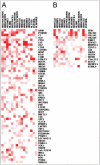Meta-analysis of age-related gene expression profiles identifies common signatures of aging
- PMID: 19189975
- PMCID: PMC2732303
- DOI: 10.1093/bioinformatics/btp073
Meta-analysis of age-related gene expression profiles identifies common signatures of aging
Abstract
Motivation: Numerous microarray studies of aging have been conducted, yet given the noisy nature of gene expression changes with age, elucidating the transcriptional features of aging and how these relate to physiological, biochemical and pathological changes remains a critical problem.
Results: We performed a meta-analysis of age-related gene expression profiles using 27 datasets from mice, rats and humans. Our results reveal several common signatures of aging, including 56 genes consistently overexpressed with age, the most significant of which was APOD, and 17 genes underexpressed with age. We characterized the biological processes associated with these signatures and found that age-related gene expression changes most notably involve an overexpression of inflammation and immune response genes and of genes associated with the lysosome. An underexpression of collagen genes and of genes associated with energy metabolism, particularly mitochondrial genes, as well as alterations in the expression of genes related to apoptosis, cell cycle and cellular senescence biomarkers, were also observed. By employing a new method that emphasizes sensitivity, our work further reveals previously unknown transcriptional changes with age in many genes, processes and functions. We suggest these molecular signatures reflect a combination of degenerative processes but also transcriptional responses to the process of aging. Overall, our results help to understand how transcriptional changes relate to the process of aging and could serve as targets for future studies.
Availability: http://genomics.senescence.info/uarrays/signatures.html.
Supplementary information: Supplementary data are available at Bioinformatics online.
Figures

Similar articles
-
Ageing transcriptome meta-analysis reveals similarities and differences between key mammalian tissues.Aging (Albany NY). 2021 Feb 11;13(3):3313-3341. doi: 10.18632/aging.202648. Epub 2021 Feb 11. Aging (Albany NY). 2021. PMID: 33611312 Free PMC article.
-
Specific age-related signatures in Drosophila body parts transcriptome.BMC Genomics. 2006 Apr 4;7:69. doi: 10.1186/1471-2164-7-69. BMC Genomics. 2006. PMID: 16584578 Free PMC article.
-
The expression signature of in vitro senescence resembles mouse but not human aging.Genome Biol. 2005;6(13):R109. doi: 10.1186/gb-2005-6-13-r109. Epub 2005 Dec 16. Genome Biol. 2005. PMID: 16420669 Free PMC article.
-
Common aging pathways in worms, flies, mice and humans.J Exp Biol. 2007 May;210(Pt 9):1607-12. doi: 10.1242/jeb.004887. J Exp Biol. 2007. PMID: 17449826 Review.
-
Transcriptional Signatures of Aging.J Mol Biol. 2017 Aug 4;429(16):2427-2437. doi: 10.1016/j.jmb.2017.06.019. Epub 2017 Jul 3. J Mol Biol. 2017. PMID: 28684248 Free PMC article. Review.
Cited by
-
PTSD is associated with accelerated transcriptional aging in World Trade Center responders.Transl Psychiatry. 2021 May 24;11(1):311. doi: 10.1038/s41398-021-01437-0. Transl Psychiatry. 2021. PMID: 34031357 Free PMC article.
-
Systems biology in aging: linking the old and the young.Curr Genomics. 2012 Nov;13(7):558-65. doi: 10.2174/138920212803251418. Curr Genomics. 2012. PMID: 23633915 Free PMC article.
-
A peripheral blood biomarker estimates probability of survival: the neutrophil-lymphocyte ratio in noncancer patients.Biomark Med. 2016 Sep;10(9):953-7. doi: 10.2217/bmm-2016-0103. Epub 2016 Aug 18. Biomark Med. 2016. PMID: 27537355 Free PMC article.
-
Integrated Microarray and RNAseq Transcriptomic Analysis of Retinal Pigment Epithelium/Choroid in Age-Related Macular Degeneration.Front Cell Dev Biol. 2020 Aug 21;8:808. doi: 10.3389/fcell.2020.00808. eCollection 2020. Front Cell Dev Biol. 2020. PMID: 32984320 Free PMC article.
-
Enrichment of apolipoprotein A-IV and apolipoprotein D in the HDL proteome is associated with HDL functions in diabetic kidney disease without dialysis.Lipids Health Dis. 2020 Sep 14;19(1):205. doi: 10.1186/s12944-020-01381-w. Lipids Health Dis. 2020. PMID: 32921312 Free PMC article.
References
-
- Ames BN, et al. Mitochondrial decay in aging. Biochim. Biophys. Acta. 1995;1271:165–170. - PubMed
-
- Andrew M, et al. Maturation of the hemostatic system during childhood. Blood. 1992;80:1998–2005. - PubMed
-
- Bruunsgaard H, et al. Aging and proinflammatory cytokines. Curr. Opin. Hematol. 2001;8:131–136. - PubMed
Publication types
MeSH terms
LinkOut - more resources
Full Text Sources
Other Literature Sources
Medical
Molecular Biology Databases
Miscellaneous

